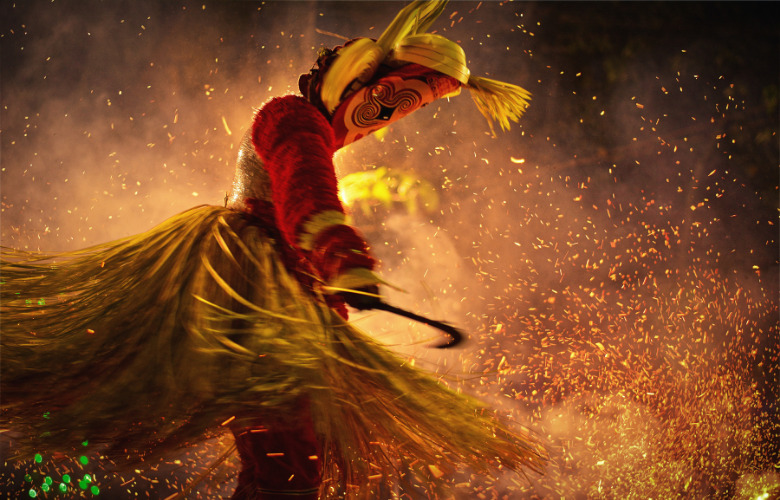
Not too long ago we looked at Indian Folk Theatre. Which led us to ask the question, “So, what is happening in contemporary theatre in India?” How did and does it develop? What are the common practices? And how deeply is the performing arts scene of today still anchored in ancient traditions? This article can by no means paint a full picture, but attempts to give you a glimpse into a fascinating creative world.
Theatre is an ancient aesthetic practice in India. Historical research suggests that the performing arts in the Indian subcontinent existed as far back as the 4th century BC.
According to the ancient Natyashastra of Bharata, an exhaustive Indian treatise on the art of performance, drama was a gift bestowed on humans by the gods.
Whereas other art forms (e.g., writing, and poetry) went through ups and downs over the centuries, it seems the performing arts thrived continuously through dance, music, song, and the telling of ancient stories.
As outlined in our earlier article, Indian folk theatre is still going strong today.
As such, it also shows a clear influence on India’s modern theatre world.
The website Asia Society states, “folk traditions, folk theatre and various other performative genres, indigenous to the soil have been available all through. If not in an unbroken, then at least as a fractured tradition. And there is of course the venerable tradition of the Sanskrit classical theatre that dates back deep in time and can still be felt.”
Modern Indian theatre has a legacy that is influenced by and draws inspiration from a myriad of sources, Indian as well as international.
However, the Western proscenium style of theatre, was not introduced in India before the late eighteenth century. It was through the British colonialists that Western proscenium style theatre reached Indian shores.
The first indigenous performance with native actors happened in 1795 when a Russian violinist by the name of Herasim Stepanovich Lebedeff staged a Hindi and Bengali mixed-language version of a short play by Paul Jodrell.
In the 1830s, under the patronage of rich native families, the first Bengali-language theatre was established. This was outside the traditional format of Indian folk performance genres.
By then, the British had established a small professional theatre production company in Calcutta. It was there that, for the first time, an Indian actor, Baishnab Charan Auddy, played Othello in 1848.
Beginning in the 1850s, the performing arts in India began to branch out more as theatre patrons dared to produce plays in new ways. Many proscenium style theatres began to pop up in the homes of the rich in different regions and cites across India.
However, this never led to the traditional theatre forms to be forgotten.
In the 1870s, the Indian proscenium-style theatre moved from the mansions of the rich to the actual ticketed theatre.
In the words of Asia Society, “By the last quarter of the 19th century, proscenium Indian theatre had gone public and turned itself into a commercial outfit that was capable of clothing and feeding those who worked for it.”
During the two world wars the Indian theatre industry was put under enormous strain. Most creative endeavours came to a halt. What little remained of a more modern proscenium theatre became very formulaic to appease the masses.
But from the early 1920s through the 40s, the freedom movement in India was gaining momentum. Which, in the end, also had a profound impact on Indian contemporary theatre.
The Indian Communist Party had been founded between the war years, in 1922. And along with it came the Indian People’s Theatre Association (IPTA), which was its cultural wing.
To again quote Asia Society, “They came up with a kind of theatre that was entirely portable and had a political agenda that was at the same time both anti-colonial as well as anti-fascist.”
“With the birth of the IPTA movement, it became increasingly evident that the time had come to challenge the convention of the commercial (and politically dispassionate and non-ideological) Indian proscenium theatre that had been established from the end of the 19th century to over a period of approximately 70 years.”
From then on, proscenium contemporary theatre became – much like Indian folk theatre – more of an art form that aimed to implement social and political change.
Improvisation became more and more important as well. While still respecting the teachings of Bharata’s Natyashastra, artists began to feel that they needed to find a better balance between self-expression and the traditional, clearly structured forms of expression.
Slowly in the last century, smaller theatre groups in the larger Indian cities would perform their own visions.
Badal Sarkar’s anti-establishment experimental theatre created a new genre of social enlightenment. He formed his first Third Theatre Group Satabdi, in the year 1967.
They used to perform drama written by Badal Sircar in Anganmancha (theatre in the courtyard).
As such, Third Theatre broke away from the strict segregation of performers and audience and allowed a more interactive way of performing. Bringing theatre to the people and engaging with them.
However, it was only in the 1990s with the advent of Forum Theatre with Janasanskriti under the leadership of Sanjoy Ganguly, that the contemporary, experimental, and improvisational theatre in India became much stronger.
9 years later, in 1999, a team from the US with Bev Hoskins and Mary Good introduced Playback Theatre to India.
Thus, Playback Theatre and Forum Theatre began to take shape in the remotest parts of India, such as Karur, Chennai, West Bengal, as well as Bangalore too.
Yours Truly Theatre, a Bangalore-based group, developed “complete the story”, an indigenous format of improvisational theatre developed under the leadership of Ranji David and Nandini Rao in 2006.
In 2009, they also developed another form of improvisational theatre called Mushyara Theatre.
The beauty of the performing arts in India is that no matter what forms it takes, theatre seems to stay as much connected to the ancient ways and traditions of drama as it seems to be driven to find new ways of expressing as well as facilitating social themes and political change. There is change yet there is also continuity.
In the poetic words of Entrepreneur in an article in 2019, “India has seen the rise, stagnation and fall of several art forms and artists. However, just as the water flows ceaselessly and seamlessly, so does the existence of art from one timeline to another.”
Sources
Theatre in India on Wikipedia
Contemporary Indian Theatre: Three Voices by Project Muse, MIT Press
Contemporary Indian Theatre – an Overview by Asia Society
Transformation in Contemporary Indian Theatre: Abhilash Pillai’s “Helen” by The Theatre Times
What Makes the Indian Theatre Industry so Ambiguous? In Entrepreneur, 2019
Khalil Oghab, the Father of Iranian Circus
The Things You Should Know About Indian Folk Theatre


Liam Klenk was born in Central Europe and has since lived on four continents. Liam has always been engaged in creative pursuits, ranging from photography and graphic design, to writing short stories and poetry, to working in theatre and shows. In 2016, Liam published his first book and memoir, 'Paralian'.
Read Full Profile© 2021 TheatreArtLife. All rights reserved.

Thank you so much for reading, but you have now reached your free article limit for this month.
Our contributors are currently writing more articles for you to enjoy.
To keep reading, all you have to do is become a subscriber and then you can read unlimited articles anytime.
Your investment will help us continue to ignite connections across the globe in live entertainment and build this community for industry professionals.